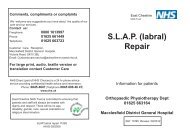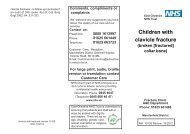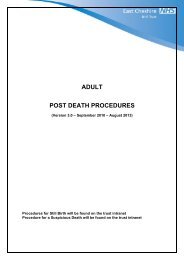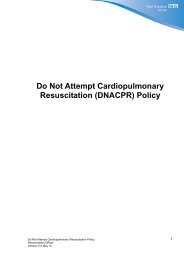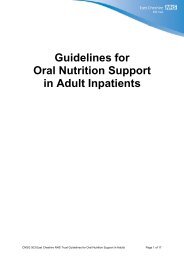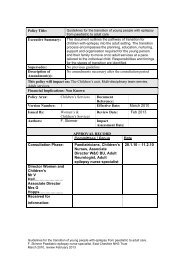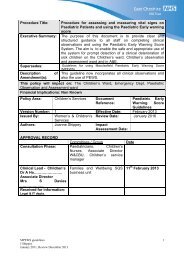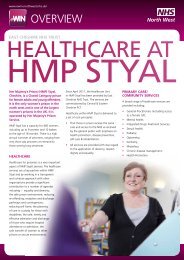Diabetes guidance 1766.pdf - East Cheshire NHS Trust
Diabetes guidance 1766.pdf - East Cheshire NHS Trust
Diabetes guidance 1766.pdf - East Cheshire NHS Trust
You also want an ePaper? Increase the reach of your titles
YUMPU automatically turns print PDFs into web optimized ePapers that Google loves.
Self-Monitoring of Blood Glucose - continuedBlood glucose patterns can be used to guide medication adjustment to improve glycaemic control.1. Patients managed by diet ± oral antihyperglycaemic medicationOnce-daily pre-prandial blood glucose monitoring (staircase method)e.g. Breakfast Lunch Evening Meal SupperDay 1xDay 2xDay 3xDay 4xOnce the medication and the patient’s lifestyle are stable it is sufficient for this to occur once weekly,on varying days, to provide information for both the patient and the Practice Nurse.Ultimately, once stable, HbA1c may be sufficient.2. Biphasic Insulin RegimenTwice daily pre-prandial blood glucose monitoringe.g. Breakfast Lunch Evening Meal SupperDay 1 x xDay 2 x xDay 3 x xDay 4 x xOnce stable, revert to daily pre-prandial blood glucose monitoring (staircase method)3. Basal Bolus Insulin RegimenDuring periods of high activity or unstable control, perform pre-prandial tests before each meal and ifsymptoms of hypoglycaemia occur. Once stable, reduce testing regimen to before breakfast and staggerat least one other time during the day (either pre-prandially or 2-hours post-prandial).4. Metformin + basal insulinTwice daily until stable then once daily while stable.5. Class 2 drivers with insulin, SU or Glinide (repaglinide/netaglinide)At least twice daily [See 2] and then before they drive.Note: 2-hour post-prandial blood glucose testing may be appropriate when HbA1c remains above targetdespite satisfactory pre-prandial readings.





